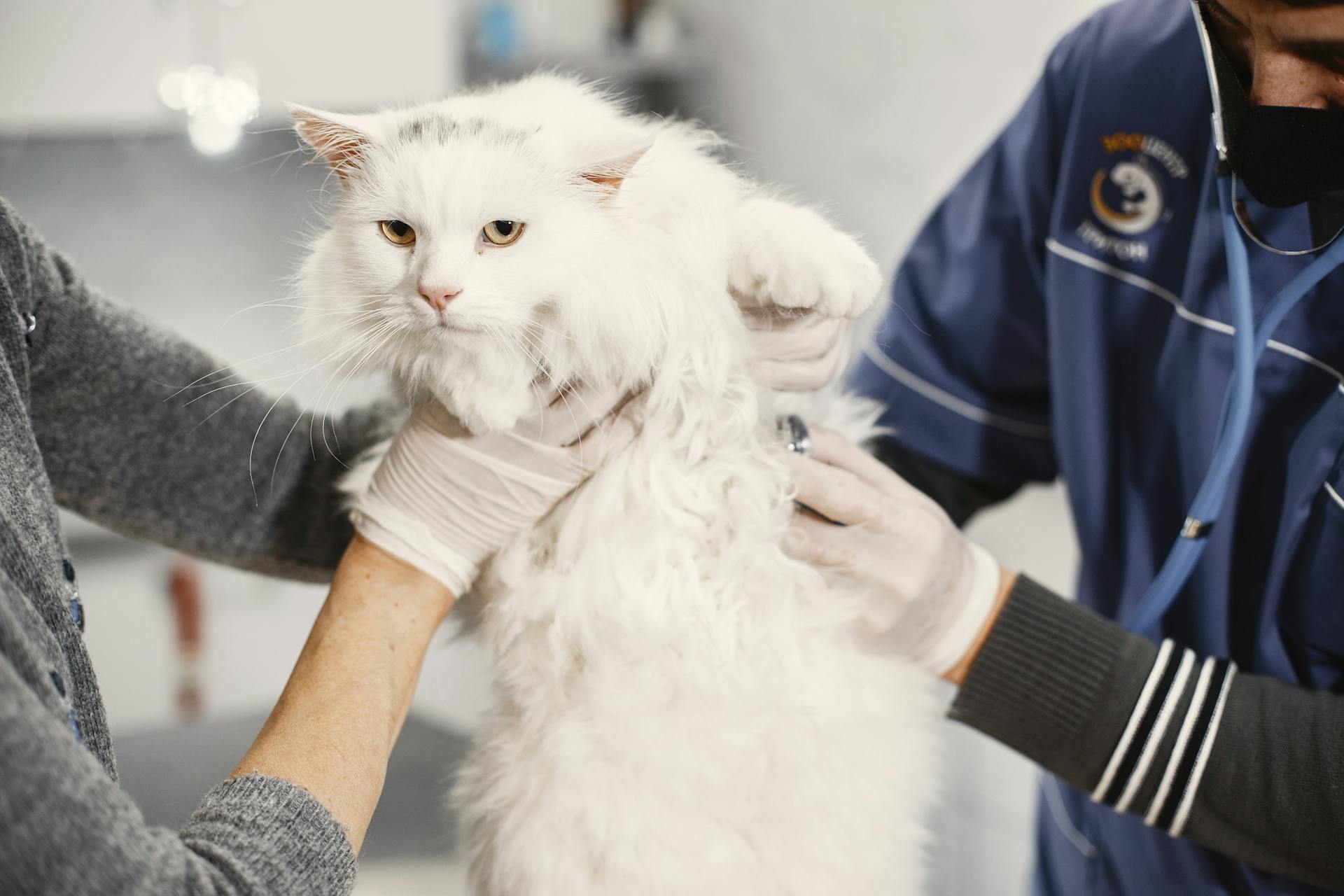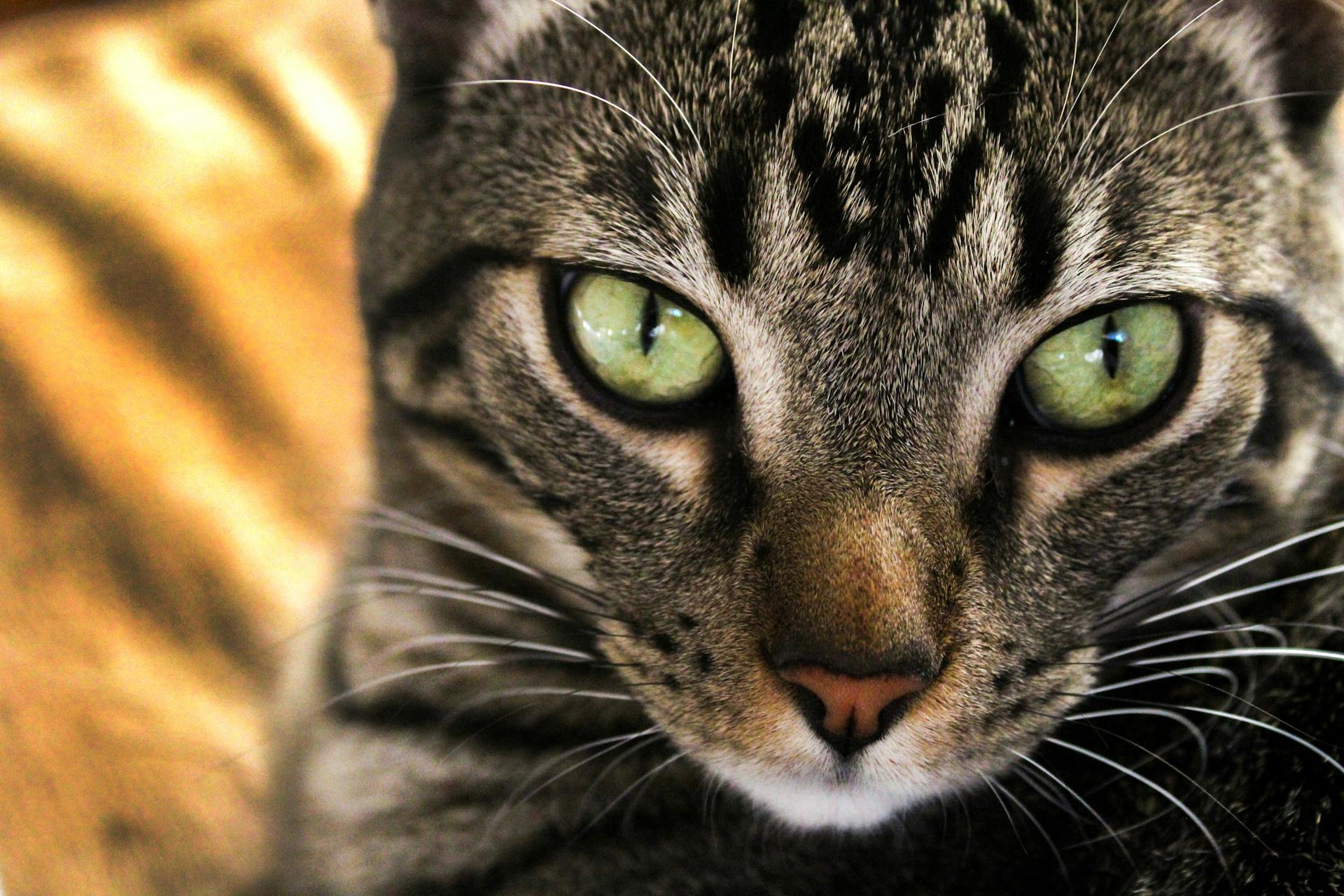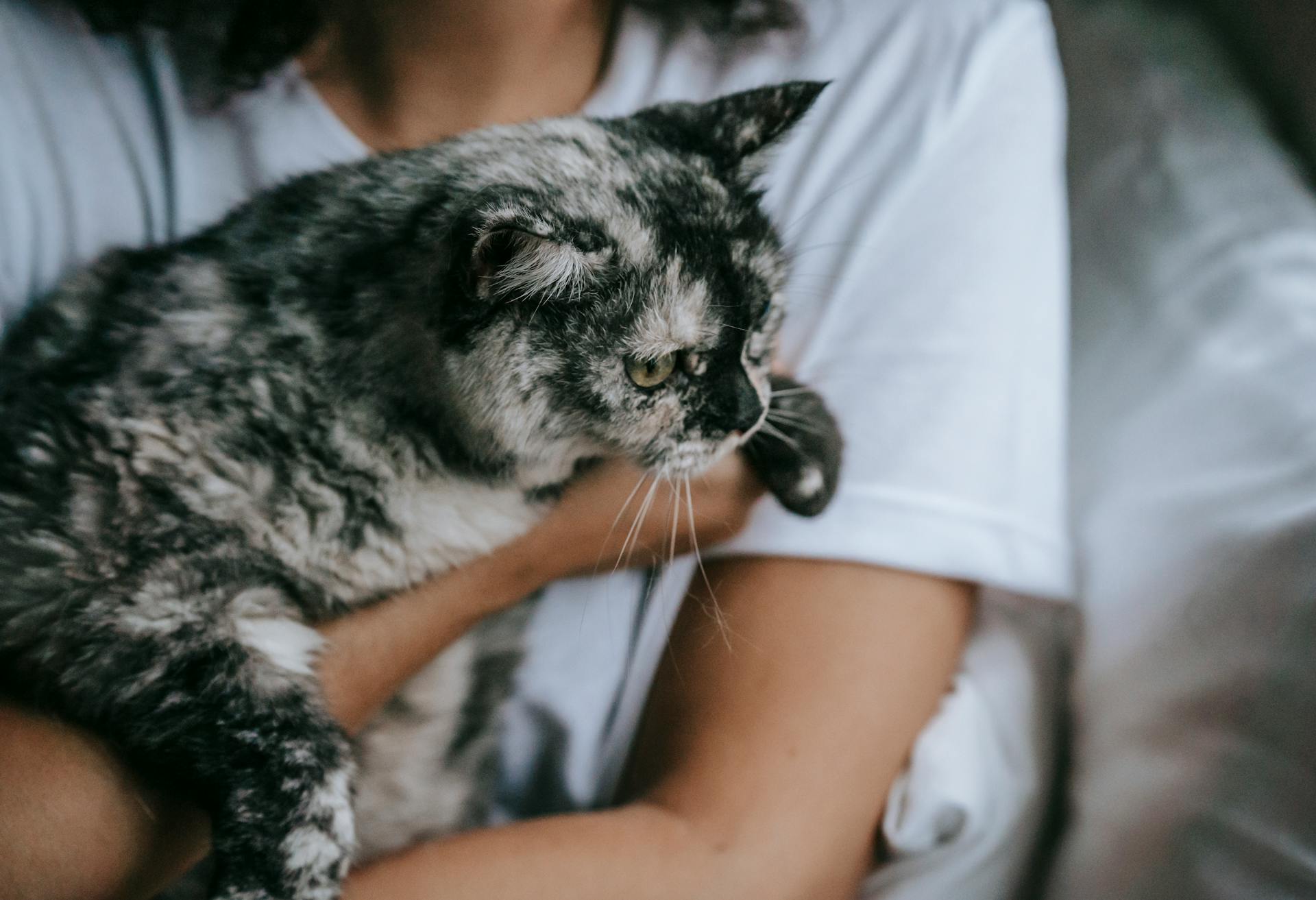
Feline IBD and lymphoma are two serious health issues that can affect your cat's digestive system and overall well-being. Feline IBD, or inflammatory bowel disease, is characterized by chronic inflammation and ulceration of the gastrointestinal tract, which can lead to diarrhea, vomiting, and weight loss.
Feline lymphoma, on the other hand, is a type of cancer that affects the immune system and can cause a range of symptoms, including weight loss, vomiting, and lethargy. Lymphoma can also cause swelling in the lymph nodes, spleen, and other organs.
The symptoms of feline IBD and lymphoma can be similar, making it difficult to diagnose the condition without proper testing and examination. However, there are some key differences between the two conditions that can help guide diagnosis and treatment.
Both conditions require prompt veterinary attention, as they can progress quickly and become life-threatening if left untreated.
A unique perspective: Doberman Pinscher Skin Problems
Introduction
Feline inflammatory bowel disease (IBD) and small cell lymphosarcoma (ScLSA) of the gastrointestinal tract (GIT) are common diseases in cats that cause similar clinical signs.
IBD is a diagnosis of exclusion, meaning it's a conclusion drawn after other possible causes have been ruled out.
These diseases are complex and multifactorial, involving the interaction of host genetics, immune system, and the intestinal microenvironment.
The etiology of ScLSA is similarly complex and poorly understood.
Standardizing the reporting of endoscopy and histopathology findings is a great help to feline practitioners.
Efforts to standardize these findings, along with advanced diagnostics such as Immunohistochemistry (IHC) and polymerase chain reaction (PCR), represent significant advances in diagnosing and treating these diseases.
A unique perspective: Common Diseases in Cocker Spaniels
Predicting GI
Predicting GI symptoms can be a challenging and emotional experience for cat parents. Unfortunately, physical exams and diagnostic procedures like ultrasounds can't accurately distinguish between IBD and GI lymphoma.
Exams and ultrasounds can detect signs such as thickening of a cat's intestines or the presence of abdominal masses, but these symptoms can show up in both IBD and GI lymphoma.
The only way to confirm if a cat has cancerous GI lymphoma vs. non-cancerous IBD is with an intestinal biopsy, which is a costly, invasive, and stressful procedure for both the cat and the cat parent.
Only 15% of cat parents choose to have biopsies performed, which means that many cat owners are left treating their cat for IBD hoping it's not cancer until a diagnosis is confirmed.
Here's an interesting read: Cancer Symptoms in Dogs Lymphoma
Helping Cat Health
Maintaining a healthy weight through a balanced diet can significantly reduce the risk of feline IBD and lymphoma.
Cats with IBD often experience chronic diarrhea, which can lead to dehydration and electrolyte imbalances if not managed properly.
Regular veterinary check-ups can help identify potential health issues early on, allowing for prompt treatment and improving overall feline health.
Feeding a high-fiber diet can help manage IBD symptoms, but it's essential to consult with a veterinarian to determine the best course of action.
A healthy gut microbiome is crucial for feline immune function, and probiotics can be a useful supplement to support gut health.
Recommended read: Dog Gut Health Test
Distinguishing Between Conditions
Basepaws' at-home DNA test provides a simple 5-second swab that can help detect genetic predispositions to diseases like IBD and GI lymphoma.
Research shows that the types and numbers of microbes in a cat's mouth can be a predictor of active diseases such as IBD.
The oral microbiome composition is also associated with both gastrointestinal cancer and IBD in humans.
This non-invasive and affordable test can give you a better understanding of your cat's health and help you distinguish between conditions like IBD and GI lymphoma.
Recommended read: Papillon Dog Diseases
Diagnosing GI Lymphoma

Diagnosing GI Lymphoma can be a challenging and emotional experience for cat owners. Unfortunately, physical exams and diagnostic procedures like ultrasounds can't accurately distinguish between IBD and GI lymphoma.
Exams and ultrasounds can detect signs such as thickening of a cat's intestines or the presence of abdominal masses, but these symptoms can appear in both IBD and GI lymphoma. This means that vets may not be able to confirm whether a cat has cancer or not through these methods alone.
An intestinal biopsy is the only way to confirm if a cat has cancerous GI lymphoma or non-cancerous IBD. However, this procedure is costly, invasive, and stressful for both the cat and its owner.
Only 15% of cat parents choose to have biopsies performed, which suggests that many owners may be hesitant to pursue this option due to its costs and invasiveness.
Changing the Future of Cat Diagnosis
For cat owners, getting a diagnosis for their feline friends can be a long and challenging process. According to Teri, a pet parent who has had experience with IBD in her cats, some vets may not even use the gold standard of care, which includes full-thickness biopsies.

Teri's experience highlights the importance of thorough testing, including full-thickness biopsies, GI/pancreatic labs, and abdominal ultrasound. This approach can help ensure that affected areas are not missed, as pinch biopsies from endoscopy may not always get to the root of the issue.
The science behind DNA testing is indeed amazing, and it has come a long way. Gloria, who lost her cat Theo to GI lymphoma, is grateful that this technology is advancing, but wishes it was already available when her cat needed it.
In some cases, cats can develop lymphoma after being diagnosed with IBD, as Teri's cat did. This emphasizes the need for ongoing monitoring and testing to catch any changes in their condition early on.
Here are some key tests that can help diagnose IBD and other conditions in cats:
- Full-thickness biopsies
- GI/pancreatic labs (TLI/PLI/Cobalamin/Folate)
- Abdominal ultrasound
These tests can provide valuable insights into a cat's condition and help veterinarians make informed decisions about their care. By staying up-to-date on the latest diagnostic techniques and technologies, pet owners can work with their vets to give their cats the best possible chance at a healthy and happy life.
Distinguishing Between IBD and Lymphoma in Cats
A non-invasive and affordable way to detect IBD and GI lymphoma in cats is being researched by Basepaws, a pet genetics company.
Their at-home cat DNA test involves a simple 5-second swab that provides deep insight into a cat's unique breed profile, traits, and genetic predisposition to disease, including IBD and GI lymphoma.
The swab also gives a snapshot of the bacteria, viruses, and fungi that make up the "microbiome" in a cat's mouth. Research shows that the types and numbers of these microbes can be a predictor of an active disease such as IBD.
In fact, different oral microbiome compositions are associated with both gastrointestinal cancer and IBD in humans, according to recent research.
A study published in 2023 found a link between intestinal S100/Calgranulin expression and chronic inflammatory enteropathy and intestinal lymphoma in cats.
Here are some key differences between IBD and lymphoma in cats:
Keep in mind that these are just some of the key differences, and a proper diagnosis can only be made by a veterinarian.
Treatment and Prognosis
The prognosis for cats with small cell lymphoma can be favorable, with some reporting a 92% response rate for a median of > 2.5 years.
For cats with feline IBD, managing the condition with a combination of dietary modification and immunosuppression can be effective, but a cure is unlikely.
The objective of treatment for feline IBD is to improve clinical signs, not to cure the condition.
A guarded prognosis may be warranted for severely debilitated patients or those with major histologic gastrointestinal lesions, eosinophilic enteritis, or hypereosinophilic syndrome.
In cases where IBD treatment is refractory, it's essential to question the client's compliance with therapy, presence of comorbidities, and the accuracy of the original diagnosis.
Collecting gastrointestinal biopsies for histologic assessment and immunohistochemistry/PCR for antigen receptor rearrangement may be necessary to confirm the diagnosis or rule out other conditions.
Understanding Feline Lymphoma
Feline lymphoma is a type of cancer that affects a cat's immune system, specifically the lymphatic system. It's estimated that 1 in 1,000 cats will develop lymphoma.
On a similar theme: Dog Digestive System
Lymphoma can occur in any part of the body, but it most commonly affects the lymph nodes, spleen, and intestines. The exact cause of lymphoma in cats is still unknown.
Cats with lymphoma may experience symptoms such as weight loss, loss of appetite, and lethargy. In some cases, lymphoma can cause swelling in the lymph nodes, which can be felt by a veterinarian during a physical examination.
The most common type of lymphoma in cats is multicentric lymphoma, which affects the lymph nodes throughout the body. This type of lymphoma is more common in cats between 6 and 15 years old.
Treatment options for feline lymphoma include chemotherapy, radiation therapy, and surgery. The goal of treatment is to control the disease and improve the cat's quality of life.
For another approach, see: Dog Suddenly Lost Hearing
Frequently Asked Questions
Can IBD turn into lymphoma?
While people with IBD have a higher risk of developing lymphoma, the overall risk remains low. However, it's essential to discuss your individual risk factors and monitoring needs with your healthcare provider.
What can be mistaken for lymphoma in cats treatment?
Lymphoma in cats can be mistaken for other conditions such as inflammatory bowel disease, kidney disease, and pancreatitis, which share similar symptoms. Accurate diagnosis is crucial to ensure proper treatment and management of the underlying condition.
How quickly does intestinal lymphoma progress in cats?
Intestinal lymphoma in cats can progress rapidly, often within days or weeks, or more slowly over months, depending on the type of cancer. Understanding the progression of the disease is crucial for effective treatment and management.
Sources
- https://pubmed.ncbi.nlm.nih.gov/33187624/
- https://ingridking.com/2022/11/22/changing-future-ibd-gi-lymphoma-cats/
- https://www.semanticscholar.org/paper/Differentiating-feline-inflammatory-bowel-disease-Sabattini-Bottero/74f6e7166de274e4fca924521778e5680939ca8e
- https://www.vetvine.com/forums/topic/848/distinguishing-between-ibd-and-alimentary-lymphoma-in-cats
- https://vetfocus.royalcanin.com/en/scientific/chronic-enteropathy-in-cats
- https://www.semanticscholar.org/paper/Differentiating-Inflammatory-Bowel-Disease-from-in-Marsilio/1ca21026de0874a0b85f529f64109d1ca236f3a0
Featured Images: pexels.com


